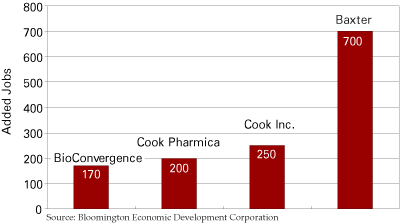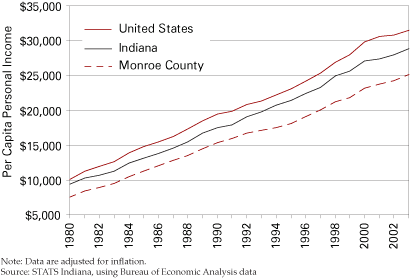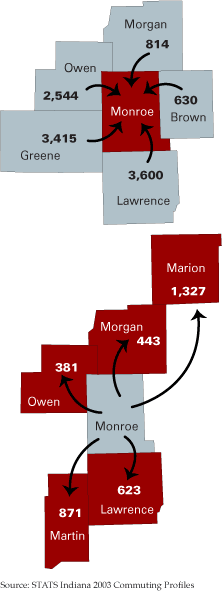Bloomington
Bloomington Economic Development Corporation
One need only look to Bloomington and Monroe County to find where the new economy is taking root. Recent announcements, ribbon-cuttings, and construction projects indicate the life sciences and advanced manufacturing sectors are alive and well. Local information technology firms are expanding, and jobs in the professional and technical services are growing.
Buoyed by the recent investments of Cook Group Incorporated and fueled through strong support and assistance from both Indiana University and Ivy Tech Community College, area companies are creating jobs. Cook Group Inc.’s investments include over $70 million in the new Cook Pharmica LLC and $12 million in an expansion of Cook Inc. These projects will create over 450 jobs, which when added to those being created by the new BioConvergence LLC and the recent expansions at Baxter Pharmaceutical Solutions total about 1,300 new jobs (see Figure 1).
Figure 1
Recent and Anticipated Life Science Jobs in Bloomington

While the job news has been mostly positive, there have been layoffs and business closings in the past year. General Electric cut nearly 500 jobs and Otis Elevator ceased manufacturing operations earlier this year, eliminating nearly 200 jobs. The most closely watched employer in the community may be Indiana University. With declining state funding and changing demographics, both enrollment and employment at Indiana University are monitored closely.
The continued decline in traditional jobs mixed with the new job growth leads to predictions of modest net job growth for the coming year. Job growth will be spread over most business sectors including hospitality, health care, and other service industries.
With the changing business mix, it remains to be seen if the local per capita income will begin to rise. The most recent per capita income data (2003) shows that Bloomington is well below the state and national income levels (see Figure 2). However, the lower per capita income can be partially attributed to college students working part time.
Figure 2
Per Capita Personal Income, 1969 to 2003

Population estimates continue to predict slow to moderate growth for the Bloomington area of just less than 1 percent per year for the next ten years. Meanwhile, the number of people commuting into Monroe County for employment continues to grow with nearly 16,000 workers driving into the county daily (see Figure 3).
Figure 3
Top Five Counties Commuting Into and Out of Monroe County

Construction activity has been strong in Monroe County since the late 1990s. Building permit activity for single-family homes has been very consistent and looks to stay that way into the future. Permits for 2005 are on track to match the annual average of five hundred new units. The major change will be in the construction of multi-family housing. With nearly five hundred new bedrooms constructed in the downtown area and large apartment complexes completed on both the east and west sides of town in recent years, there is currently only one project under consideration.
Local planners report that 2005 has been a strong year for office, commercial, and industrial construction. Work continued on a new Hilton Garden hotel, Monroe Hospital (the community’s second hospital), the first office building in North Park, Cook Pharmica, Cook Inc., and BioConvergence. Lighter caseloads currently in local planning departments may indicate a decline in the area’s construction industry for 2006.
Bloomington’s economy continues to transition. The presence of a large research university and a regional community college continues to provide stability for the current economy and a workforce for the new economy. Successful entrepreneurs who start and grow their businesses in the community, continued emphasis on development in the life science and information technology sectors, and strategic public investments should allow for continued, though modest, growth and improvement in the local economy.
Also in this Issue…



